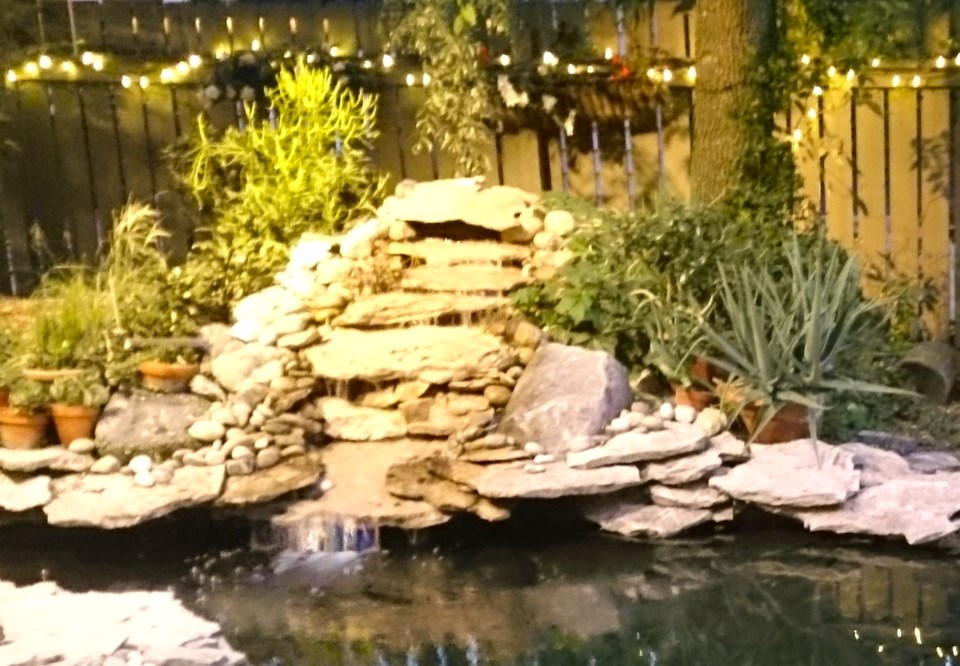Water gardens are a beautiful addition to any landscape. However, this spring chore can be physical, so it might be good to have some help to get your water garden up and running.
Begin by removing any floating debris from the water. I am often amazed at the amount of “stuff” that ends up in the pond over the winter. If you have a pond with a flexible liner, then it is necessary to leave water in the pond over the winter. If you have a concrete lined pond the opposite is true and the water is removed prior to freeze-up. In spring, if there is old water in the pond, it needs to be removed and fresh water put in. Removing the water that has been in the pond since last fall can be done by pail or by pump. My pond is large so a pail is out of the question. I use the same pump to remove the water as I do in the summer to circulate the water. However, to keep the pump in good running order I place the pump in a fine mesh bag in order to ensure that debris in the pond does not get into the pump.
If you have any native pond plants still in the pond, they can be set up on the pond edge to allow good access to the entire pond. A good job while you are waiting for the pond to fill is to prune any old or damaged leaves off of these plants. If the pot is overgrown, then now is a good time to repot. There are many different opinions on what kind of media to use but regardless of the media, ensure that you place a couple of inches of pea gravel on top to keep that media in the pot.
Once the water is removed, add additional water to clean out the last of the “muck.” I like to use a corn broom to help remove any algae that is still stuck to the pond sides. If you happen to live in warmer climes you will need to pay attention to keeping some of those bacteria in place to keep the water balanced for the fish. However, on the prairies, it is not so typical for people to overwinter their fish outside. Although not impossible, it is in my opinion a phenomenal waste of energy. Because the pond fish are coming from an aquarium to the pond, I ensure that the water is ultra clean. Once the water is again clean, leave the pond without plants or fish for a few days and add any treatments necessary for keeping the fish safe. This gives the water time to warm up appropriately.
As far as plant go – there is an endless array that you can add to your water garden. Plants add colour and interest but more importantly keep your pond water cleaner. There are three types of plants to use in your water garden.
Oxygenator plants act as a natural filter in the pond. They use nutrients that algae would otherwise use, so having oxygenators will help to minimize the formation of algae. They also will produce oxygen that is needed by the fish. Some good choices for oxygenator plants include monkey tail, water crowfoot, water violet, hornwort and parrots feather.
Marginal plants would be typically found around the edge of a water body. They should be placed to look natural, as if they would normally grow there. In a man-made pond it is not always wet around the pond so to get a bog or a marginal area, simply bury a piece of pond liner or pvc that will hold water and create a bog. Good marginal plants include the native marsh marigold, sweet flag iris and the not so hardy yellow monkeyflower.
Floaters are plants the will cover the surface of the water. They are either plants that entirely float on the surface or plants that are potted and have leaves that will float on the water surface. They shade the water and help to keep the production of algae at a minimum. Waterlilies are of course the favourite floating flower of the pond. They need full sun and prefer still water. In order to get the best bloom, using fertilizer tabs is a must. Other floaters that are commonly used include water hyacinths, water lettuce and floating heart. Try to have enough floaters that 60 per cent of the water surface is covered.
Hanbidge is the Lead Horticulturist with Orchid Horticulture. Find us at www.orchidhort.com; by email at [email protected]; on facebook @orchidhort and on instagram at #orchidhort.
Tune into GROW Live on our Facebook page https://www.facebook.com/orchidhort or check out the Youtube channel GROW https://www.youtube.com/channel/UCzkiUpkvyv2e2HCQlFl0JyQ?





